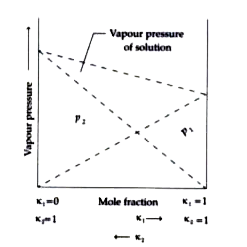Raoult’s Law for a Solution of Two Miscible Liquid || Vapour Pressure and Liquid Composition Curve || Calculation of Mole Fraction in Vapour Phase
Step by step video solution for Raoult’s Law for a Solution of Two Miscible Liquid || Vapour Pressure and Liquid Composition Curve || Calculation of Mole Fraction in Vapour Phase by Chemistry experts to help you in doubts & scoring excellent marks in Class 12 exams.
Updated on:21/07/2023Similar Questions
Knowledge Check
Read the passage given below and answer the following questions :
Raoult's law states that for a solution of volatile liquids, the partial vapour pressure of each component of the solution is directly proportional to its mole fraction present in solution. Dalton's law of partial pressure states that the total pressure Ptotal over the solution phase in the container will be the sum of the partial pressures of the components of the solution and is given as:
Ptotal= P1+ P2

What type of deviation from Raoult's law does the above graph represent ?AFirst positive then negativeBNegative deviationCPositive deviationDFirst negative then positiveThe vapour pressures of pure liquids A and B are 400 and 600 mm Hg respectively at 298 K. On mixing the two liquids, the sum of their initial volumes is equal to the volume of the final mixture. The mole fraction of liquid B is 0.5 in the mixture. The vapour pressure of the final solution, the mole fractions of components A and B in vapour phase, respectively are :
A450 mm Hg 0.5 , 0.5B450 mm Hg 0.4 , 0.6C500 mm Hg 0.4 , 0.6D500 mm Hg 0.5 , 0.5A mixture of two miscible liquids A and B is distilled under equilibrium conditions at 1 atm pressure. The mole fraction of A in solution and vapour phase are 0.30 and 0.60 respectively. Assuming ideal behaviour of the solution and the vapour, calculate the ratio of the vapour pressure of pure A to that of pure B.
A4B3.5C2.5D1.85
The liquids X and Y from ideal solution having vapour pressures 200 and 100 mm Hg respectively. Calculate the mole fraction of component X in vapour phase in equilibrium with an equimolar solution of the two .
View SolutionAt 298K , the vapour pressure of pure liquid n-butane is 1823 torr and vapour pressure of pure n-pentane is 521 torr and form nearly an ideal solution.
a. Find the total vapour pressure at 298K of a liquid solution containing 10% n-butane and 90% n-pentane by weight,
b. Find the mole fraction of n-butane in solution exerting a total vapour pressure of 760 torr.
c. What is composition of vapours of two components (mole fraction in vapour state)?
View SolutionCamparison between Liquid and Vapour Composition || Determination OF Mole Fraction in Liquid Phase and Vapour Phase || Vapour Pressure OF Different Concentrate/distillate || Solved Numerical Class Question (JH Shortcut)
View SolutionVapour Pressure|Factors Affecting Vapour Pressure|Vapour Pressure Of Solutions (Raoult's Law)|Questions|Relation Between Mole Fraction In Solution Phase And Vapour Phase|Summary
View SolutionThe vapour pressure of pure liquid A at 300K is 577 Torr and that of pure liquid B is 390 Torr. These two compounds form ideal liquid and gaseous mixtures. Consider the equilibrium composition of a mixture in which the mole fraction of A in the vapour is 0.35. Calculate the total pressure of the vapour and the composition of the liquid mixture.
View Solution
